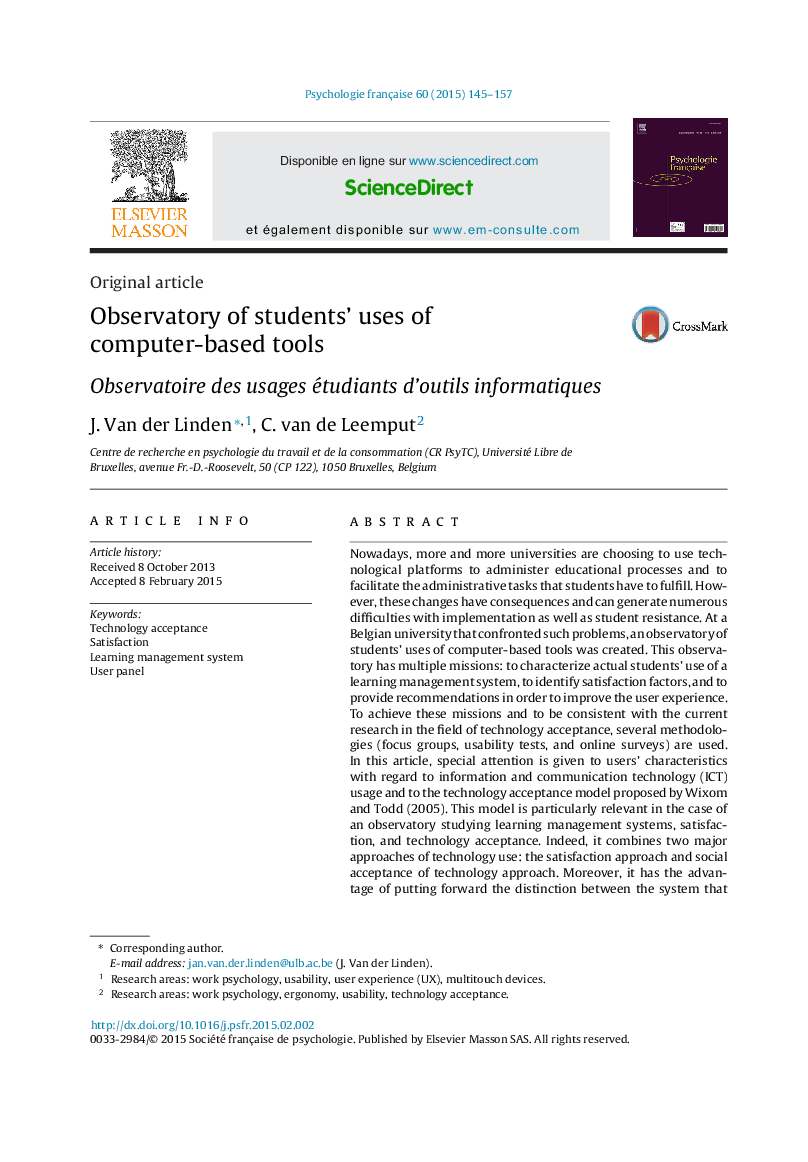| کد مقاله | کد نشریه | سال انتشار | مقاله انگلیسی | نسخه تمام متن |
|---|---|---|---|---|
| 336971 | 547404 | 2015 | 13 صفحه PDF | دانلود رایگان |
Nowadays, more and more universities are choosing to use technological platforms to administer educational processes and to facilitate the administrative tasks that students have to fulfill. However, these changes have consequences and can generate numerous difficulties with implementation as well as student resistance. At a Belgian university that confronted such problems, an observatory of students’ uses of computer-based tools was created. This observatory has multiple missions: to characterize actual students’ use of a learning management system, to identify satisfaction factors, and to provide recommendations in order to improve the user experience. To achieve these missions and to be consistent with the current research in the field of technology acceptance, several methodologies (focus groups, usability tests, and online surveys) are used. In this article, special attention is given to users’ characteristics with regard to information and communication technology (ICT) usage and to the technology acceptance model proposed by Wixom and Todd (2005). This model is particularly relevant in the case of an observatory studying learning management systems, satisfaction, and technology acceptance. Indeed, it combines two major approaches of technology use: the satisfaction approach and social acceptance of technology approach. Moreover, it has the advantage of putting forward the distinction between the system that ICT departments control and the information that other university departments have released on the system. The results showed that the students mentioned having good competence in the use of ICT tools and that the usability difficulties they encountered and dissatisfactions they expressed can be attributed primarily to the system used and secondarily to the information presented on this system. Both factors negatively influence the intention of using the system. More precisely, regression analysis indicated that reliability, flexibility, integration, aesthetics, and available features influence the perceived system quality, while completeness, accuracy, relevance, comprehensibility, and currency of the information presented on the system influence the perceived information quality. The creation of such an observatory allows one to simultaneously study users’ acceptance and satisfaction, to differentiate the impact of personal and technical factors, and to consider the evaluation processes of technological usage at the university.
RésuméLes universités recourent de plus en plus souvent à des plateformes technologiques afin d’administrer les processus éducatifs et faciliter les tâches administratives des étudiants. Cependant, ces changements sont conséquents et engendrent souvent de nombreuses difficultés d’implémentation. C’est dans ce cadre qu’un observatoire des usages technologiques étudiants a été créé. Cet observatoire a pour missions de déterminer l’usage effectif des technologies, des étudiants, d’identifier les facteurs de satisfaction et de fournir des recommandations à l’université. Pour arriver à ces fins, plusieurs méthodologies (groupes de discussion, tests d’utilisabilité, questionnaires) sont utilisées. Les résultats montrent que les difficultés et insatisfactions dues au système utilisé et aux informations présentes sur ce système influencent négativement l’acceptation du système. La création d’un tel observatoire permet tout à la fois d’étudier l’acceptation et la satisfaction des utilisateurs, de différencier l’impact des facteurs personnels et techniques, ainsi que de s’interroger sur les processus d’évaluation des outils lors de leur implémentation.
Journal: Psychologie Française - Volume 60, Issue 2, June 2015, Pages 145–157
